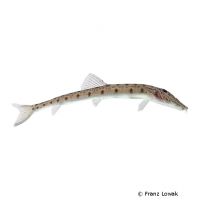Longnose Loach (Acantopsis dialuzona)
| Longnose Loach Acantopsis dialuzona | |
|---|---|
| Name | Longnose Loach |
| Name Lat. | Acantopsis dialuzona |
| Family | Longfin Loaches |
| Family lat. | Cobitidae |
| Order | Carps |
| Order lat. | Cypriniformes |
| Origin | Southeast Asia |
| Habitat | Streams, rivers |
| Diet | Carnivore |
| pH | 6.0-8.0 |
| Behavior | Peaceful |
| Keeping | Individual, group |
| Care Level | Moderate |
| Reproduction | Oviparous |
| Breeding | None reported |
| Life Span | 10-12 years |
| Protection | No |
| Metric Units | |
| Size | 20 cm |
| Temperature | 23-28 °C |
| Hardness | 1-12 °dH |
| Aquarium | 100 cm / 200 l |
| US Units | |
| Size | 7.9" |
| Temperature | 73-82 °F |
| Hardness | 18-214 ppm |
| Aquarium | 50 gal |
Distribution and habitat
Proboscis loaches are widely distributed in Vietnam, Laos, Cambodia, Thailand, Malaysia and Indonesia. They live mainly in flowing waters with soft sandy bottoms, but can also be found in floodplains and rice fields during the rainy season.
Maintenance
The aquarium should have dense planting, shady hiding places (roots, stones, caves), some subdued light (floating plants) and a medium strong current. To be able to burrow in, they need a soft, fine-grained, 5-10 cm deep substrate (sand, round gravel), which can be covered with some foliage (e.g. sea almond tree or oak leaves).
No ammonia, ammonium and nitrite should be detectable, the nitrate value should not exceed 100 mg/l. To ensure the water quality and oxygen content, a filter and heater adapted to the aquarium size is required, as well as lighting for the species-appropriate day-night rhythm of the animals.
Diet
They feed mainly on bottom-dwelling small crustaceans (bosmids, ostracods, etc.). The food supply consists of live food, such as cyclops, daphnia, artemia, bosmids, tubifex and mosquito larvae, which is also eaten freeze-dried or in frozen form, plus commercially available frozen special food mixtures, supplemented with high-quality dry food (pellets, tablets, granules and flakes), which is well accepted
It is recommended to feed small portions several times a day. Only as much should be fed as is eaten within a few minutes. A regular and varied diet promotes health and prevents deficiency symptoms.
Behaviour and compatibility
They are peaceful and sociable fish that can be well socialized with not too small fish. At least 5, but preferably more animals must be kept together. Older, individually kept animals sometimes behave aggressively
Basically, only mutually compatible fish species with similar demands on water quality and water temperature may be socialized.
Sex dimorphism
There are no known external distinguishing characteristics.
Reproduction and breeding
There are no known reports of successful breeding in the aquarium.
Important
According to their origin, they come in different color variations.
They are mainly crepuscular to nocturnal and remain mostly hidden in caves or under stones and roots during the day
When disturbed or threatened, they burrow into the soft substrate at lightning speed. They can be lured out of the bottom with food. They are able to adapt their color to the substrate.
When catching them, use nets with as fine a mesh as possible so that the subocular spines (under the eye), which are normally hidden under the skin, do not get caught.
The well-being of the fish should be checked regularly. Temperature should be checked daily, pH, hardness and nitrate levels at least every 14 days. Regular partial water changes are recommended, even if the contaminant level has not yet reached the upper limit. Sudden changes in water quality should be avoided. Newly introduced fish must be accustomed slowly to the water in the aquarium.
Further literature can be found in your pet store.
References
Text: petdata; Image: Franz Lowak
Source: BMELV (1998): Tierschutzgutachten - Haltung von Zierfischen (Süßwasser); RIEHL & BAENSCH (2006): Aquarien Atlas Bd. 1, Mergus Verlag; ENGELMANN (2005): Zootierhaltung - Tiere in menschlicher Obhut: Fische, Verlag Harri Deutsch
- Gemäß § 21 Abs. 5 Tierschutzgesetz idgF
